Swell Classification Guidelines
Significant: Winter - Swell 8 ft @ 14 secs or greater (11+ ft faces) for 8+ hours (greater than double overhead).
Summer - Head high or better.
Advanced: Winter - Swell and period combination capable of generating faces 1.5 times overhead to double overhead (7-10 ft)
Summer - Chest to head high.
Intermediate/Utility Class: Winter - Swell and period combination generating faces at head high to 1.5 times overhead (4-7 ft).
Summer - Waist to chest high.
Impulse/Windswell: Winter - Swell and period combination generating faces up to head high (1-4 ft) or anything with a period less than 11 secs.
Summer - up to waist high swell. Also called 'Background' swell.
Surf Heights for Hawaii should be consider 'Hawaiian Scale' if period exceeds 14 secs.
On
Monday, March 21, 2016
:
- Buoy 106 (Waimea Bay): Seas were 8.4 ft @ 14.3 secs with swell 6.6 ft @ 13.6 secs from 341 degrees.
- Buoy 46025 (Catalina RDG): Seas were 3.6 ft @ 12.8 secs with swell 2.3 ft @ 13.4 secs from 263 degrees. Wind northwest 14-16 kts. Water temperature 61.7. At Santa Barbara swell was 2.7 ft @ 12.3 secs from 259 degrees. At Santa Monica swell was 2.4 ft @ 12.9 secs from 260 degrees. Southward from Orange County to San Diego swell was 2.1 ft @ 13.6 secs from 249 degrees.
- Buoy 46012 (Half Moon Bay)/029 (Pt Reyes): Seas were 9.3 ft @ 15.4 secs with swell 3.5 ft @ 18.4 secs from 306 degrees. Wind south 14-16 kts. Water temp 57.0 degs.
Notes
Buoy 46059, Hi-res Buoys
PACIFIC OVERVIEW
Current Conditions
On Monday (3/21) in North and Central CA surf was 3-4 ft overhead and petty lumped up from south wind and not rideable except at protected spots. At Santa Cruz surf was shoulder to maybe head high and reasonably clean with underlying lump and reasonably lined up but soft. In Southern California up north waves were waist high or so and clean and lined up but weak and inconsistent. Down south waves were waist high and pushing out of the north with a heavy north texture on it and swamped by tide. Hawaii's North Shore was getting another pulse of north swell from the Gulf with waves 8 ft and clean. The South Shore was flat and clean. The East Shore was getting the same north swell with waves 2 ft overhead and chopped from southeast wind.
See QuikCASTs for the 5 day surf overview or read below for the detailed view.
Meteorological Overview
Swell is hitting Hawaii and California from a gale that redeveloped in the Gulf of Alaska on Fri-Sat (3/19) with 34 ft seas pushing southeast mid-way between Hawaii and Southern CA. The swell is fading in Hawaii and building in CA. After that a small gale is forecast for the Northeastern Gulf on Tues-Wed (3/23) producing maybe 30 ft seas aimed east targeting mainly the Pacific Northwest. By Sat (3/26) another gale is forecast developing in the Northwest Pacific producing 30 ft seas approaching the dateline and forecast to slowly fade through Mon (3/28) there with sea fading to 23 ft. The Inactive Phase of the MJO is still in effect, but is forecast to move out with the Active Phase queued up behind. So there's some hope for the future.
SHORT- TERM FORECAST
Current marine weather and wave analysis.cgius forecast conditions for the next 72 hours
North Pacific
Overview
Jetstream
On Monday AM (3/21) the jet was trying to consolidate just east of Japan with winds 130 kts , then .cgiit about half way to the dateline with the northern branch tracking east on the 40N latitude line pushing into North CA. A bit of a trough was off the CA coast supported by 130 kts winds offering some support for gale development but also likely setting up weather for California. The southern branch was easing southeast from the .cgiit point tracking just south of Hawaii and eventually moving inland over mainland Mexico just south of Baja. In all a pretty weak and poorly organized jet but showing some signs of improvement. Over the next 72 hours into Thurs AM (3/24) the .cgiit point is to migrate east to about the dateline with with west of there consolidated and trying to build some velocity, up to 140 kts at the end of the period. East of the dateline the jet is to remain .cgiit and weak except for a small trough forecast developing over the Western Gulf moving to just off British Columbia on Wed (3/23) but with no real obvious winds to fuel gale development. Beyond 72 hours starting Thurs (3/24) another tough is to build in the .cgiit portion of the jet starting in the Western Gulf tracking east supported by 120 kt winds offering some support for gale development into Fri (3/25). But by Sat (3/26) winds to build to 190 kts in the consolidated portion of the jet reaching to the dateline forming a trough north of it offering some better support for gale development in the Northwest Pacific and that trough is to move to the dateline by Mon still being fed by 190 kt winds with the .cgiit point in the jet moving to a point 900 nmiles north of Hawaii. Much improved support for gale development possible. But a wide .cgiit is to be east of that point supporting only high pressure down at the oceans surface. The emergence of the Active Phase of the MJO in the West Pacific is to be fueling this transition with the Inactive Phase of the MJO moving east over the far East Pacific.
Surface Analysis
On Monday (3/21) swell from a gale in the Gulf was producing a second pulse of surf in Hawaii and also starting to show in North CA (see Gulf Gale below).
Over the next 72 hours a gale is forecast forming in the Gulf of Alaska on Tues AM (3/22) with winds building over a small area to 45 kt from the northwest starting to get traction on the oceans surface. Seas building to 27 ft at 43N 155W (294 degs NCal). By evening west winds to be 45 kts with seas building to 30 ft over a tiny area at 47N 149W (302 degs NCal). On Wed AM (3/23) west winds to be fading from 45 kts but lifting north with seas still 30 ft at 49N 146W (310+ degs NCal). Fetch to be fading from 40 kts in the evening still lifting north with seas 32 ft at 50N 142W (318 degs NCal). This system to track northeast from there and out of the NCal swell window getting ready to move onshore over Central Canada. Possible small northerly swell to result for North and Central CA.
Gulf Gale (Swell #13)
On Tues PM (3/15) a gale formed 850 nmiles north of Hawaii producing 35 kt north winds targeting the Islands with seas on the increase. On Wed AM (3/16) the gale tracked east some generating 35-40 kt north winds and seas building from 23 ft targeting Hawaii well at 35N 154W (10 degs HI). In the evening winds built to 45-50 kts from the north with seas to 28 ft over a small area at 40N 152W and starting to to swing to the east (14 degs HI). Still solid sideband swell was targeting the Islands. On Thurs AM (3/17) 45 kt northwest winds were in.cgiay but aimed all southeast towards California with seas 33 ft at 40N 151W aimed east at Central and Southern CA (286 degs NCal, 292 degs SCal). Fetch faded from 40 kts from the west in the evening with seas fading from 29 ft at 41N 150W aimed east (287 degs NCal, 293 degs SCal). The gale faded in it's south quadrant Fri AM (3/18) but rebuilt in it's west quadrant with northwest winds back to 40-45 kts and seas building from from 25 ft at 44N 160W targeting midway between California and Hawaii. 40-45 kt northwest winds held in the evening with seas building to 31 ft at 43N 162W targeting Hawaii (356 degs) and the US West Coast (294 degs NCal). The gale faded from there Sat AM (3/19) with 40 kt northwest winds and seas 35 ft at 40N 157W with sideband energy tracking towards both Hawaii (006 degs) and the US West Coast (286 degs NCal, 293 degs SCal). 35 kt northwest winds held into the evening starting to track east with 30 ft seas at 39N 150W targeting Central and South CA (286 degs NCal, 292 degs SCal). This system dissipated from there with 30 kt northwest winds fading Sun AM (3/20) off the California coast with seas fading from 25 ft at 38N 146W (284 degs NCal, 292 degs SCal). Residual west winds were barely 35 kts in the evening with seas fading from 25 ft at 38N 140W. Monday Am seas were fading from 22 ft 400 nmiles west of Monterey Bay aimed. Some solid swell to result for California.
Hawaii: On Mon AM (3/21) swell from the second pulse of this system was fading from 6.6 ft @ 13-14 secs early (9.0 ft). nothing is to be left by Tues AM (3/22). Swell Direction: 360-010 degrees.
North CA: Additional energy building late Monday (3/21) from the second pulse of this storm reaching 11 ft @ 16 secs at sunset (17.5 ft). Swell peaking overnight and fading Tues AM (3/22) from 11.0 ft @ 14-15 secs (15.5 ft). Residuals fading Wed AM (3/23) from 8 ft @ 12-13 secs (10 ft) and maybe a hari more resembling something rideable. Swell Direction: 285-287 degs
Southern CA: Longer period energy from the second pulse building late Monday. Swell building through the day Tues (3/22) pushing 5.0 ft @ 16 secs (7.5 ft) late. Swell fading but still holding decently on Wed (3/23) from 5 ft @ 15 secs (6.5 ft). Residuals fading on Thurs (3/24) from 3.4 ft @ 12-13 secs (4 ft). Swell Direction: 292-294 degrees
North Pacific Animations: Jetstream - Surface Pressure/Wind - Sea Height - Surf Height
Tropical Update
No tropical systems of interest are being monitored.
California Nearshore Forecast
On Monday AM (3/21) southwest winds at 15 kts were in.cgiay from San Francisco northward building late afternoon and northwest winds were 10 kts south to Pt Conception and also building later. Light rain building from just north of San Francisco during the day pushing south to Big Sur in the evening. Light snow snow for Tahoe starting 10 AM building in the later evening fading out by 7 Am Tuesday with 18 inches accumulation possible. High pressure is to be right behind with northwest winds 15-20 kts Tues AM (3/22) everywhere including Southern CA. Light spotty showers fading early from SF northward. Snow fading early for Tahoe through snow showers might reappear later in the day. Northwest winds 15-20 kts for most of the state Wed and Thurs, but northeast for Southern CA. North winds and high pressure continue for North and Central CA on Fri (3/25) building late to 25 kts and Sat at 20-25 kts but Southern CA to be protected in an eddy with light southwest winds. More high pressure and north winds Sunday at 25 kts continuing Monday and reaching into Southern CA. Say goodbye to warm water.
South Pacific
Overview
Surface Analysis
On Sun AM (3/20) a gale tracked east through the deep Central South Pacific resulting in 38 ft seas at 67S 140W then fading from 31 ft in the evening at 67S 135W. 30 ft seas were fading while tracking east on Mon AM (3/21) at 66S 130W, then fading. Background swell possible for SCal a week out but most of this energy was focused on Chile.
Over the next 72 hours another gale is to track under New Zealand on Tues AM (3/22) with 32 ft seas at 63S 175W fading then possibly regenerating Thurs AM (3/24) in the Southeast Pacific with 32 ft seas at 52S 124W and lifting northeast. Secondary fetch to build behind on Fri AM (3/25) with seas to 35 ft at 58S 137W lifting northeast in the evening with seas 35 ft at 51S 128W, then fading. Something to monitor.
South Pacific Animations: Jetstream - Surface Pressure/Wind - Sea Height - Surf Height
LONG-TERM FORECAST
Marine weather and forecast conditions 3-10 days into the future
North Pacific
Beyond 72 hours a new broader gale is to develop in the Northwest Pacific on Fri PM (3/25) producing 40 kt west winds and 27 ft seas over a small area at 45N 170E. 40-45 kt west fetch to hold in this area Sat AM (3/26) with seas to 30 ft at 45N 173E (321 degs HI). 40 kt west winds to hold in the same general area in the evening with seas still 30 ft at 45N 175E (325 degs HI). Sun AM (3/27) 40 kt northwest winds to continue with a broader area of 28 ft seas at 39N 177E (326 degs HI). A slow fade to set in through Mon AM (3/28) with winds down to 35 kts and seas 23 ft at 42N 177W (324 degs HI). A possible long run of rideable surf to result for Hawaii if all goes as forecast.
South Pacific
Beyond 72 hours another gale is forecast tracking under New Zealand on Sun (3/27) with 37 ft seas but falling a bit southeast. Probably nothing to result given the southeast travel path of the storm.
More details to follow...
Active Phase of MJO Moving into West Pacific
El Nino Warm Pool in Steady Decline
The Madden Julian Oscillation is a periodic weather cycle that tracks east along the equator circumnavigating the globe. It is characterized in it's Inactive Phase by enhanced trade winds and dry weather over the part of the equatorial Pacific it is in control of, and in it's Active Phase by slack if not an outright reversal of trade winds and enhanced precipitation. The oscillation occurs in roughly 20-30 day cycles (Inactive for 20-30 days, then Active for 20-30 days) over any single location on the.cgianet, though most noticeable in the Pacific. During the Active Phase in the Pacific the MJO tends to support the formation of stronger and longer lasting gales resulting in enhanced potential for the formation of swell producing storms. Prolonged and consecutive Active MJO Phases help support the formation of El Nino. During the Inactive Phase the jet stream tends to .cgiit resulting in high pressure and less potential for swell producing storm development. The paragraphs below analyze the state of the MJO in the Pacific and provide forecasts for MJO activity (which directly relate to the potential for swell production).
Overview: A strong El Nino has developed. It began its lifecycle in late 2013 as a primer WWB and Kelvin Wave developed. Then in early 2014 a historically strong push by the Active Phase of the MJO resulted in a large Kelvin Wave, and anomalies continued in the Spring into early Summer transporting more warm water eastward. But the cycle faltered in July due to a protracted bout of the Inactive Phase of the MJO which enabled the upwelling phase of the Kelvin Wave cycle to manifest driving cooler water east, muting warm water buildup along the Ecuador coast. Still the warm water pipe remained open, but surface temperatures near the Galapagos never recovered and any atmospheric momentum was lost. Then in early 2015, another historically strong push from the MJO occurred, effectively a repeat of the early 2014 event, invigorating the warm water transport process and, adding more heat to an already anomalously warm surface pool off Ecuador. That pool built steadily in spurts, peaking in the Oct-Nov, timeframe, then began a slow decline. But even in Jan 2016, the strongest Westerly Wind Burst of the event occurred, with another Kelvin Wave developing. And another weaker one occurred in Feb. But it was too little too late. There was not any real warm water left in the West Pacific to transport east. El Nino was in a steady collapse by mid-Feb with the subsurface warm reservoir in the East Pacific in steep decline with cool water ready to move in migrating from the west. The paragraphs below describe the current status of various El Nino indicators, followed by a paragraph that ties all the pieces together and provide our analysis of what is to come.
KWGA/Equatorial Surface Wind Analysis & Short-term Forecast:
Analysis from TAO Buoys: As of Sun (3/20) calm winds were south of the equator from 160E to 175W from 4S and points southward, or basically over a tiny area. Otherwise east winds prevailed and strong over the entire zone mainly north of the equator. No marked anomalies were indicated in the Kelvin Wave Generation Area. El Nino was being well suppressed by the Inactive Phase of the MJO.
1 Week Forecast: Very weak west anomalies developed starting 3/19 near 150E and are forecast to hold through at least 3/28. But 'weak' is the operative word. Previously solid west anomalies developed in the KWGA on 2/16 building to WWB status 2/23 continuing through 3/2, then fading to just anomalies before dissipating on 3/9 as the Inactive Phase of the MJO started taking root in the West Pacific. This was WWB #6 for the 2015-2016 season. And now another very weak westerly anomaly event is supposedly in.cgiay, which would theoretically provide positive influence for the jetstream, but we're not seeing that yet. No east anomalies are forecast. The only east anomalies that occurred in 2015 and 2016 (so far) in the KWGA were from 12/7-12/17 during an Inactive Phase of the MJO. For now a very weak El Nino pattern continues to hold control.
Kelvin Wave Generation Area wind monitoring model: West and East
Comparison of 2 Strong Westerly Wind Bursts (WWB)
On left the massive WWB in late June/July that created large Kelvin Wave #3. On right the current WWB that is generating Kelvin Wave #4.
Scales are a little different but notice anomalies in the July event at 12-14 m/s est (24-28 kts) and now in Oct at 13-14 m/s (26-28 kts)
(Click to Enlarge Images)
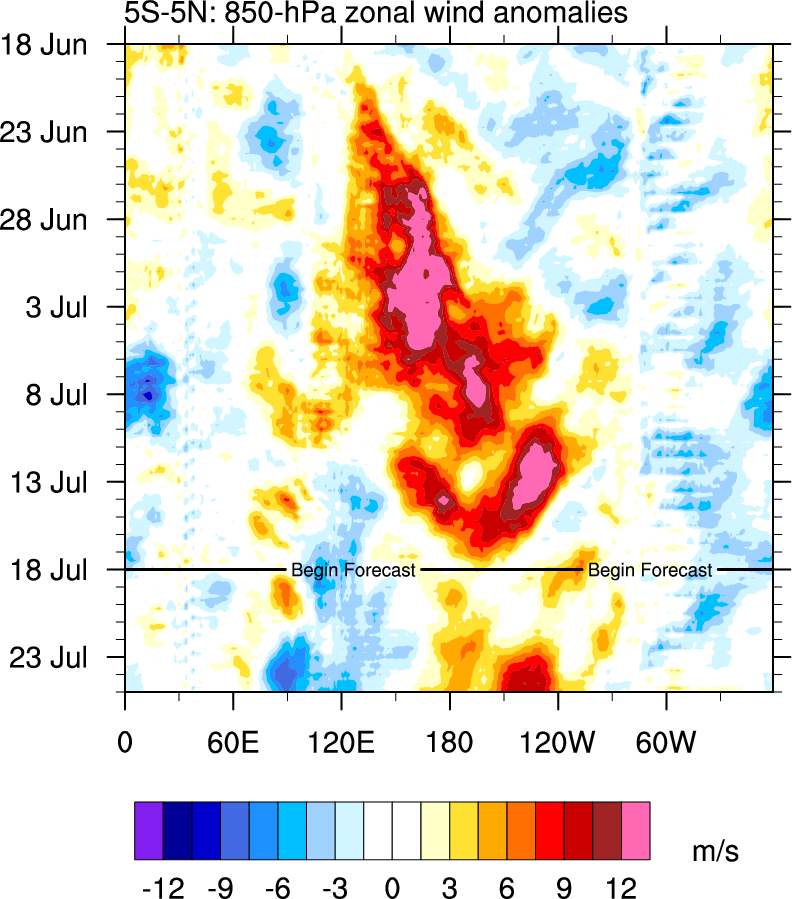
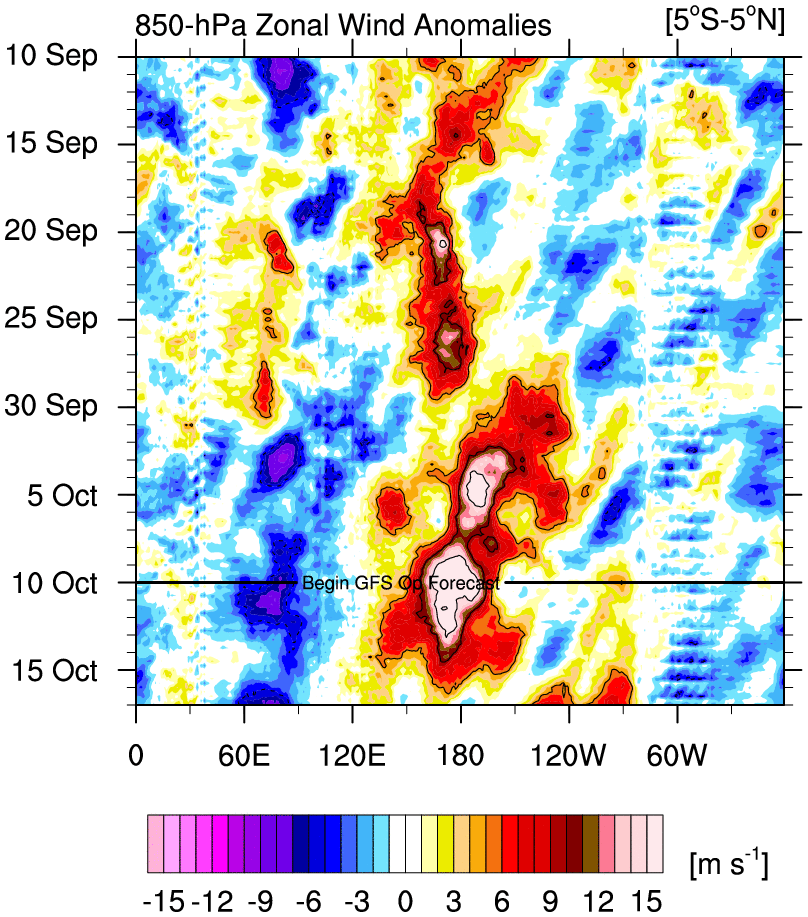
Longer Range MJO/WWB Projections:
OLR Models: As of 3/20 a weak Inactive Phase of the MJO was fading mostly east of the dateline centered south of Hawaii with the Active Phase over New Guinea reaching east almost to the dateline. The Statistic model projects the Active Phase moving east over the West Pacific the next 7 days then weakening on the dateline 2 weeks out. The dynamic model depicts the same thing but with the Active Phase fading 1 week out in the West Pacific and a dead neutral pattern taking hold 2 weeks out. This suggests El Nino influence of the jetstream building about a week out as the MJO begins to constructively interfere with it starting 3/23 but then backing off some.
Phase Diagrams 2 week forecast (ECMF and GEFS): (3/21) The ECMF model indicates a weak Active MJO signal just west of the dateline and east of the Maritime Continent. It is to track east over the next 2 weeks moving over the West Pacific but steadily weakening. The GEFS depicts the same general pattern but with the MJO stalling over dateline and collapsing. West winds/anomalies in the KWGA are to supposedly build some, perhaps feeding the jetstream flow and supporting a improving storm track by the end of the month.
40 Day Upper Level Model: (3/21) A modest Active Phase was just east of New Guinea and forecast to track east to Central America through 4/8. A weak Inactive Phase to return to the West Pacific 4/15moving to the East Pacific 4/25.
CFS Model beyond 1 week (850 mb wind): The Inactive Phase of the MJO was loosing control of the Pacific west of the dateline and is to track east through 3/28. No west winds anomalies are in.cgiay on the dateline. Fuel for the jetstream and therefore storm production is gone. The model depicts west anomalies redeveloping weakly on the dateline 3/28 as the Active Phase of the MJO pushes east. It is to move over the West Pacific 3/31 holding through 4/30. Modest west anomalies are forecast through that window and extending beyond the end of the Active Phase till 5/5. Another Inactive Phase to develop starting 5/10 but not shutting down west anomalies completely until mid-May, driven mainly by El Nino. Good support for fueling the jetstream and therefore storm development during that window (3/28-5/5).
CFSv2 3 month forecast for 850 mb winds, MJO, Rossby etc
Subsurface Waters Temps
TAO Array: (3/21) Actual temperatures remain decent but are fading. A large pocket of 29 deg temps were at depth between 140E to 158W with the 28 deg isotherm line reaching east to the Galapagos, the furthest east of this event. Anomaly wise things are collapsing. +2 deg anomalies have disappeared west of 132W as of 3/20. 3 deg anomalies are all but gone except over a tiny area from 117W eastward and down only 20 meters (very shallow). In fact the entire warm pool only extends 75 meters deep at most. This is the last of the El Nino subsurface reservoir. No warmer temps remain. Cool subsurface waters are down at 150m and racing east now reaching the Ecuador Coast with -2 deg anomalies reaching east to 120W down at 100 meters. The warm pool is is steep decline. Per the hi-res GODAS animation posted 3/14 the reservoir is fading and very shallow but warm water is still flowing into it from the dateline attributable to Kelvin Wave #6 at +2-3 deg anomalies. A tiny area of +3 deg anomalies attributable to WWB #5 was fading from 110W to Ecuador. The subsurface reservoir is shrinking steadily. Kelvin Wave #5 and #6 are resisting to total collapse of this ENSO event and the onset of La Nina, but the end of even that is in sight.
Sea Surface Height Anomalies (SSHA): (3/14) The image depicts the warm pool in rapid decline. 0-+5 cm anomalies are holding for the moment covering the entire equatorial Pacific starting at 170W (easing east). Peak anomalies have redeveloped at +15 cm near 130W. +10 cm anomalies are fading in coverage between 122W-150W. The subsurface warm pool rebuilt slightly on 3/8, but is fading now, sustained only by weak Kelvin Waves #5 and #6.
Upper Ocean Heat Content: (3/14) Temps are fading fast. +0.5-1.0 deg anomalies are fading from 108W extending east to the Galapagos. No real anomalies have formed from WWB #6. No Kelvin Wave is expected to result. No warmer anomalies exist. This El Nino remains westward di.cgiaced and even that is in rapid decline.
Surface Water Temps: The more warm water in the equatorial East Pacific means more storm production in the North Pacific during winter months (roughly speaking). Cold water in that area has a dampening effect. Regardless of what the atmospheric models and surface winds suggest, actual water temperatures are a ground-truth indicator of what is occurring in the ocean. All data is from blended infrared and microwave sensors.
Satellite Imagery
Hi-res Nino1.2: (3/20) The latest image indicates temps are fading some from the Galapagos westward but a thin warm pocket of +2/25 deg anomalies is holding on the equator from the Galapagos to 123W. A pocket of cooler water (0.0 degs) is from Columbia to the Galapagos. +2.25 deg anomalies also remain in pockets along the coast of Peru but are fading fast. Warming in Nino1.2 peaked on 7/14 then crashed and has been trying to rebuild ever since.
Hi-res Nino 3.4: (3/20) The latest image depicts this area is fading with no +2.25 deg anomalies remaining. It's over.
Hi-res 7 day Trend (3/19): Solid warming is occurring in one pocket over the Galapagos. Otherwise slow cooling is occurring over the equator from the Galapagos to the dateline with a marked pocket near 100W. The warm pool is collapsing
Hi-res Overview: (3/19) The El Nino signal is still very much present but is on the decline. A pocket of +2-3 degs above normal attributable to Kelvin Wave #5 is between 100W to 132W. 2 deg anomalies are also out at 160W attributable to Kelvin Wave #4. These temps peaked as of 3/10.
Historical Comparison of Strong El Nino's
Images built using 2 data sets - Monthly OISSTv.2 (left) & ERSSTv4 (right) This years data valid through November.
Both images/datasets suggest this is the warmest the NINO3.4 region has ever been. Now the question becomes: Will that translate in weather and swell? If the theory that temps in this area translate in stormier weather, then the answer is obvious.
Requisite Disclaimer - Current performance is no indication of future performance.
(Click to enlarge)
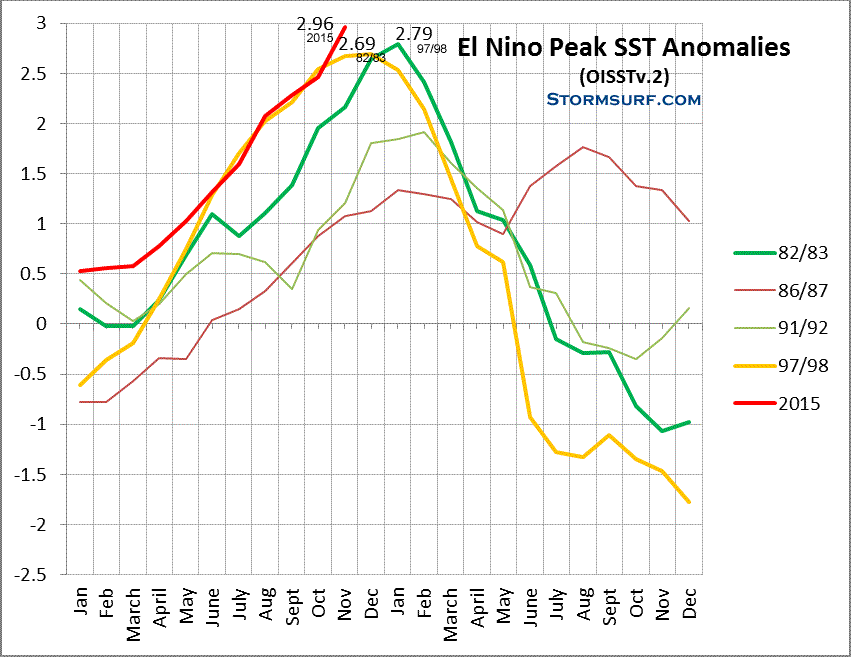
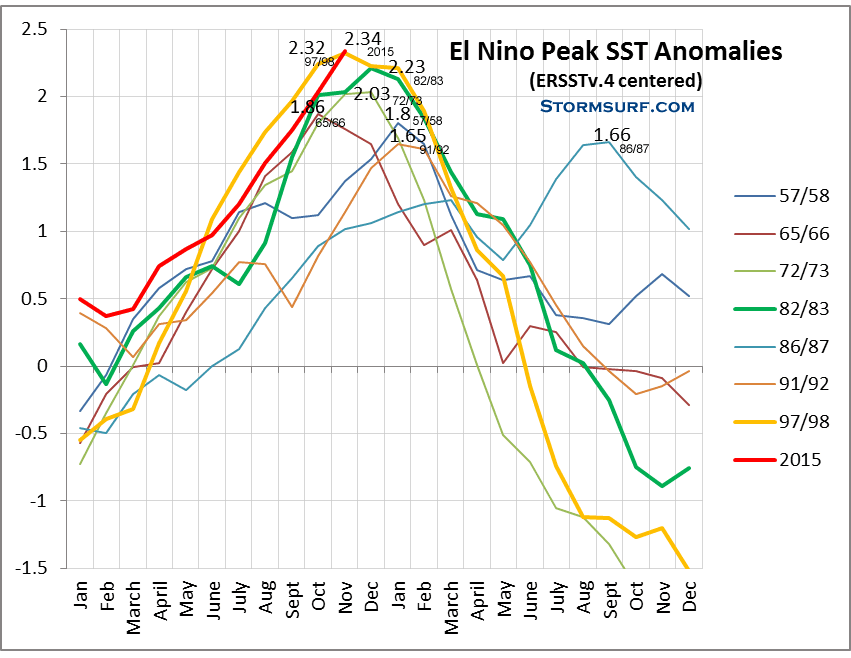
Kelvin Wave #3 Eruption Evolution
(click to enlarge)
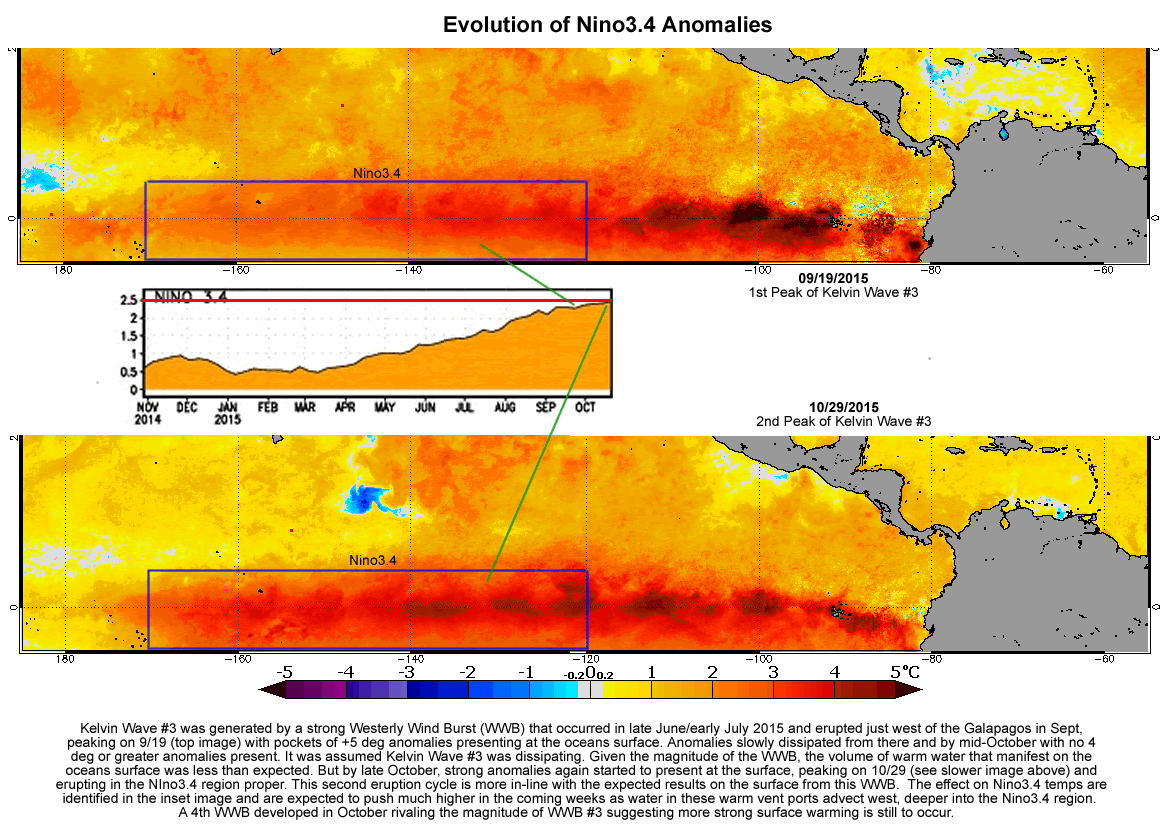
Other Sources
TAO Data: +1.0 anomalies are in control over the entire equatorial East Pacific advecting west from the Galapagos covering the entire area west to the dateline and beyond. The +0.0 anomaly line on the equator is not present (formally at 140E). +1.5 deg anomalies are extending west to 178E and east to at least 95W. There is no +2.0 deg anomalies over the Central equatorial Pacific any longer, and they are now isolated to the east between 130W to 100W with a small pocket of +2.5 deg anomalies embedded within it. Overall the warm water signature is decent but on the decline.
Nino1.2 Daily CDAS Index Temps: (3/21) Today temps were holding at +0.694 degs. Recently temps started building 2/23, rising from a low of +0.5 degs in mid-Feb peaking on 3/11 at +1.52 degs and have been fading slowly since. Previously they peaked here for 5 days at +2.581 near 10/8 and previously at +3.0 degs on 7/3, faded, then spiked again on 7/13 at +3.0 degs and yet again at +3.0 degs on 7/22.
Nino 3.4 Daily CDAS Index Temps: Today (3/21) temps were steady at +1.745 degs. From 2/25-3/11 they were steady at about +2.023. They fell below the +2.1 mark on 2/25 for the first time since when this El Nino first started developing, and below the +2.5 deg range that was reached in late Dec through Feb 11. The all time peak was reached at +3.041 on 12z 11/19. This temp beat the previous all time high of +3.028 degs (12Z 11/17), Temps have not been below +2.0 degs since 8/21.
Nino3.0 CDAS Index Temps: (3/21) Today's values were steady, at +1.686. They had been steady from 2/13-3/9 at about +1.9 degs, but otherwise started declining 1/16. Peak temps occurred 12/6 at +2.989, and +2.990 (11/28).
Nino3.4 Monthly Temps The centered Nino3.4 temps for the month of Feb were +2.19 (beating '98 which was +1.89 and '83 which was +1.84). Jan readings were +2.23 (beating '98 which was +2.21 and '83 which was +2.13). December was +2.31 (beating 97 which was +2.23 and 82 at +2.21). November was +2.36 degs (beating the highest temp recorded in '97 Nov - +2.32 degs and beating '82 +2.03 degs). Oct temps were +2.03 degs. See updated graphs above. The ONI uses a 3 month running average.
ONI For 2015 for the 3 month period centered on Sept, Oct, Nov and Dec the values are: +1.8, +2.1. +2.2 +2.3. For the same period in '97 the values were: +2.0, +2.2, +2.3 and +2.3. And for '82 the values were: +1.5, +1.9, +2.1 and +2.1. This make this years El Nino the second strongest on record since 1950.
Note: ERSSTv4 'centered' data is not available for Nino1, 3 and 4 regions, only Nino3.4.
Pacific Counter Current: As of 3/12 the current was strong from the east on the equator from 100W to 140E. Anomaly wise - they were strong from the east over the same area. There were no pockets of west anomalies indicated. El Nino is in solid decline based on this data, which would be normal for this point in the El Nino lifecycle.
SST Anomaly Projections
CFSv2 Uncorrected Data depicts peak temps were reached at +2.95 degs on Nov 5, then faded slightly in early December to +2.8 holding to Feb 1. Then a sharp decline started with temps down to +2.5 degs mid-Feb and falling from +2.0 degs in early March. The forecast indicates temps fading fast to +1.4 by 4/1, then slowing their decline before stabilizing at +0.8 degs in August before starting to rebuild in Oct. This would still be El Nino threshold temps. Hard to believe and is a minority opinion.
IRI Consensus Plume: The mid-Jan Plume depicts temps peaked in Jan, at +2.8 degs. The consensus suggests temps to fall steadily from here forward, down to -0.7 by October. See chart here - link.
Atmospheric Co.cgiing Index's (lagging indicators rather than driving oceanic change):
Daily Southern Oscillation Index (3/21): It was falling at -5.80. The 97 El Nino had daily values at -40 to -50 in early Nov with one spurt to -76 Jan 30-31st. Notable deep readings in this 2015-16 event were: -49.70/-46.60 on Oct 3 & 4, -42.20 on 10/14, -47.50 on 12/3, -38.50 on 1/2, -40.20 on 2/17. Then the peak of this event occurred 2/22 at -50.30 and -49.10 on 2/29.
30 Day Average: Was rising from -13.15. The peak low was recorded on 1/26/16 at -24.89, with a secondary peak on 3/6 at -23.00. Another peak occurred on 10/9 at -22.72, beating the previous peak low of -20.95 on 8/21, with the previous lowest at -20.49 on 7/18/15. This is exactly where we want to be (at -20 or lower).
90 Day Average: Was falling some from -14.56. A record low of -19.28 occurred on 10/16 and was matched on 10/20. The previous record low was -18.56 on 9/16. A recent low of
SOI trend - Tahiti (looking for low pressure here): On 3/21 neutral pressure was south of Tahiti and is to continue through Wed (3/23). But after that weak low pressure is to start building just south of Tahiti, eventually collapsing 3/26 but with high pressure also collapsing in the South Pacific. The SOI is expected to hold for the next 2 days, then possible start falling based on the Tahiti contribution and offer better support to enhance El Nino and fuel the jetstream assuming the low builds as forecast.
ESPI (like SOI but based on satellite confirmed precipitation): (3/21) Today's value was falling some at +1.28, having peaked recently on 3/12 at +1.57. The other recent peak was +2.33 on 1/14. It also peaked at +2.40 on Sat (10/17) and was steady in the +2.5 range through 8/10, then began falling. Historically the peak of the '82 El Nino was +2.2 and the '97 event +2.85. This suggests the '15-16 El Nino is still reasonably well co.cgied with the atmosphere, more so than some of the other indices indicate.
Multivariate ENSO Index (MEI) (Feb) These numbers were released March 5th and indicate the index decreased slightly to +2.12. In Feb the readings increased slightly by 0.08 to +2.20, holding it in the third highest since 1950 behind the '82/83 and '97/98 El Ninos. Since it has not reached the +3.0 standard deviation level, it is NOT considered a Super El Nino, nor is it expected to reach that status. The Nov ranking was +2.31, up barely from +2.23 (Oct), down from it's peak of +2.53 in Sept, and from +2.37 in Aug. The top 6 events since 1950 in order are: '97, '82, '15, '91, '86, and '72 with '97 and '82 classified as 'Super El Nino's' because they reached 3 standard deviations (SD) above normal. '91 and '86 were at about 2.2 and 2.1 respectively with '72 peaking at 1.8 SD's above the norm.
Pacific Decadal Oscillation: The PDO turned from a 6 year negative run (2008-2013) in early 2014 and has been mostly above +1.5 all of 2015. In Jan 2016 it was +1.53 and up to +1.75 in Feb. Looking at the long term record, it is premature to conclude that we have in-fact turned from the negative phase (La Nina 'like') to the positive phase (El Nino 'like'), but the data suggests that could be a real possibility. We've been in the negative phase since 1998 through at least 2013 (15 years). By the time it is confirmed (4-5 years out), we will be well into it.
North Pacific Jetstream (3/21) Detailed analysis is in the NPac Short Term Forecast above. The jet looks weak now and is forecast to hold for about a week negatively influenced by the Inactive Phase of the MJO, but then is to move into a better.cgiace later in the month as the Active Phase of the MJO takes over the dateline region.
Comparing the 2015 El Nino to '82 and '97
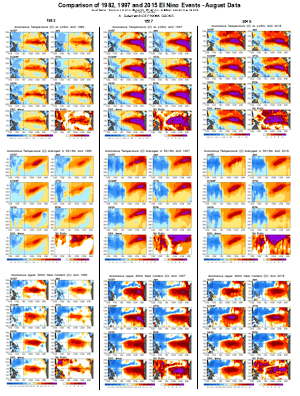
(Click to enlarge)
Conclusion: This El Nino is the 3rd strongest El Nino since 1950 based primarily on the MEI. Centered Monthly Nino3.4 data suggests it is the 2nd strongest. Based on California precipitation, this one does not compared to any major El Nino in recent memory. Some precip is occurring in CA but is not MJO related, and more likely El Nino related. Based on surf, El Nino has had the expected affect producing 13 significant class swells in the North Pacific so far this season. The target is 16, but that appears ambitious.
From a pure El Nino perspective, the peak of the event is over. But from a teleconnection standpoint, the warm pool in Nino3.4 is still imparting solid energy to the atmosphere. The Inactive Phase of the MJO is in control now and destructively interacting with the influence on the jet stream and storm production. And this will continue until the next Active Phase of the MJO comes into.cgiay, perhaps late in March. Still with season moving towards Spring, the veracity of that influence will not be a strong as previous Active Phases in winter.
The focus now turns to how quick and how much will the jet be affected for the Fall and Winter of 2016-2017. It's too early to know anything definitive yet, but with the PDO still positive, it is possible the transition to La Nina may not be a strong as in past events.
See imagery in the ENSO Powertool
****
External Reference Material: El Nino Southern Oscillation (ENSO), Madden Julian Oscillation (MJO), Pacific Decadal Oscillation (PDO), Southern Oscillation Index (SOI), Kelvin Wave
Add a STORMSURF Buoy Forecast to your Google Homepage. Click Here:

Then open your Google homepage, hit 'edit' button (top right near graph), and select your location
Local Interest
Updated - Stormsurf Video Surf Forecast for the week starting Sunday (3/20): https://www.youtube.com/watch?v=e5cyCLuoLq8&feature=youtu.be&hd=1
For automatic notification of forecast updates, subscribe to the Stormsurf001 YouTube channel - just click the 'Subscribe' button below the video.
- - -
 |
Casa Noble Tequila If you are looking for an exquisite experience in fine tequila tasting, one we highly recommend, try Case Noble. Consistently rated the best tequila when compared to any other. Available at BevMo (in California). Read more here: http://www.casanoble.com/ |
Mavericks Invitational Pieces Featuring Stormsurf:
http://www.bloomberg.com/video/how-to-predict-the-best-surfing-waves-EsNiR~0xR5yXGOlOq2MqfA.html
http://www.cbsnews.com/videos/surfs-up-for-mavericks-invitational-in-calif/
Time Zone Converter By popular demand we've built and easy to use time convert that transposes GMT time to whatever time zone you are located. It's ion left hand column on every page on the site near the link to the swell calculator.
Read all the latest news and happenings on our News Page here
Surf Height-Swell Height Correlation Table